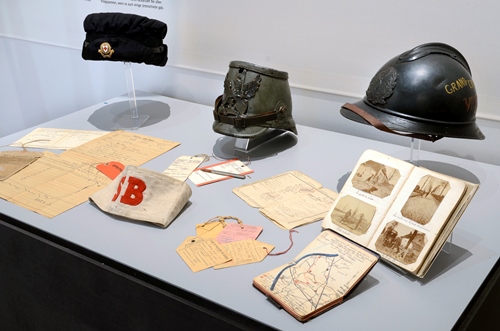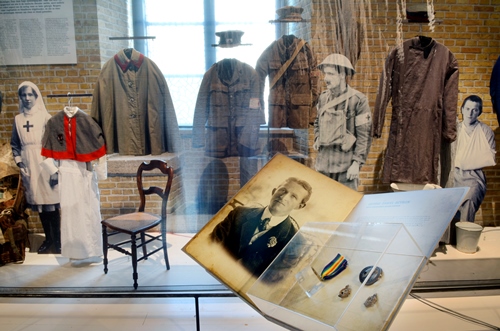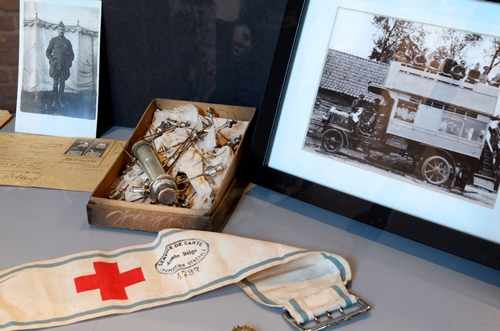30/10/2013
- Ieper
- Source: In Flanders Fields Museum
In Flanders Fields Museum
Temporary exhibition - dual exhibition Ypres - Ghent
WAR & TRAUMA
Soldiers & Ambulances, 1914-1918
In Flanders Fields Museum, Ypres
Soldiers & Psychiatrists, 1914-2014
Museum Dr. Guislain, Ghent
From 1 November 2013 to 30 June 2014
The Starting point
The First World War caused an unknown number of victims with the huge fire power deployed in this first industrialised war by the most modern global armies at the time. Millions of soldiers and civilians became wounded or sick. But none of the warring armies had seriously thought about evacuation or medical care at the start of the war, nor invested in it. It is only during the war that the medical organisation developed.
In the meantime the protracted trench war also resulted in a very large group of psychologically traumatised men who were initially only dealt with in disciplinary fashion by the military command ...
Now, at the start of the remembrance centennial it is important to tell this story of the Great War.
Two museums, in Ypres and Ghent, join forces for the first time to make a dual exhibition on the subject. It is no exhibition in two parts, but a dual exhibition by two large museums about the same big subject. Both museums present themselves as usual, refer to each other and both tell their part of the story. Not to be missed ....
 Overview of the exhibition
Overview of the exhibition
The exhibition, in an inspiring design by
Totems, Amsterdam, leads us - from the chaos of the first war year to all aspects of medical care on and behind the front line: the shortages in the initial phase of the war were remedied by the great commitment of individuals, many of them volunteers. We see the types of injuries and illnesses, the structure of evacuation lines that have left their traces in the war landscape of the Westhoek to this day, we examine specialisation in care and the evolution in medicine … The exhibition uses numerous testimonials, in word, image and objects, never before shown to the public, on loan from personal collections or foreign museums.
The first war year
Chaos, improvisation, voluntary initiative…
Because the army commands had invested too little in the shelter and care of the wounded, medical care required a high level of improvisation. Doctors and nurses in the armies did what they could but had to watch how the wounded did not reach them quickly enough for treatment in the chaos. The available aid staff, such as stretcher-bearers, paramedics or nurses, usually had only been trained little or not at all, and there was a great shortage of drugs and bandages. There were not enough doctors present on the front. Many fatalities in the first war months were due to late intervention. The wounded were sometimes in transit for days until they could be given the appropriate care. It was all about making do and improvising to make the best of it.
The solidarity with the victims of war was great. Both affected civilians and soldiers could count on a lot of support. In the whole allied world volunteers took initiatives to alleviate the need on the front. Doctors and nurses, but also wealthy people with initiative and authority took action for the many victims. From great patriotic feelings and a sense of adventure, but also out of a sense of duty towards those affected, motorised ambulances were bought and manned with volunteers, doctors and nurses were trained who offered their services to the armies. The British, French and Belgian Red Cross, but definitely also the German Red Cross, tried to deploy those private initiatives as usefully as possible in the proximity of the battles.
The
Friends Ambulance Unit deserves special attention. This was an association of Quakers who opposed violence from religious convictions. Organised in Sections Sanitaires Anglaises those volunteers helped evacuating French wounded between Nieuwpoort and Ypres. But they made a name for themselves mainly by aiding the population of Ypres and region. In close consultation with the local people they were active at many levels: urgent medical aid, hygiene and prevention, drink water supply and the evacuation of the wounded and needy during the typhoid epidemic of the first war year. 3
The lack of motorised ambulances was recognised by the medical services of the armies. At the general mobilisation doctors were instructed in the Belgian Army to commandeer motor vehicles and transform them into ambulances.
Dr. Albert De Moor was appointed to create such a C.A.A.B (Colonne d’Ambulances automobiles et de brancardiers) in the 2nd Army Section. He succeeded in his task. Not only did he have a motorised unit with 60 vehicles ready in a few weeks, but he also crossed the slow command structure, which enabled him to act independently and quickly. In the period of the Uitvallen uit Antwerpen (Aug-Sep1914) his team evacuated more than 1000 wounded and in the Battle of the Yser (18 October – 10 November 1914) more than 1600, including a number of French soldiers.

Both in the armies and at personal level the best professional powers were committed to accommodation and care. The medical world, but intellectuals too, tried to face the chaos. That did not always succeed, but various talents such as physicist
Marie Curie (from August 1914), American neurosurgeon
Harvey Cushing (from spring 1915), British doctors such as Henri Souttar, Hector Munro, Henri Tonks (all in 1914) and many others enrolled. Candidates flocked to the armies and Red Cross services to be deployed as doctors or nurses. Besides the British Souttar and Munro the commitment of
Antoine Depage of the Red Cross in De Panne is mainly important for the Westhoek front. In July 1915 the American
Mary Borden founded a hospital in the French sector of the Belgian front.
Wounded and Sick
An overview of the types of injuries and illnesses and the chances of survival. Also attention to the car for civilians as collateral damage of (e.g.) typhoid, gas attacks and shellings and air raids.
Shellshock
Psychological traumas were special, recognised medically for the first time and reluctantly recognised as "shellshock" in WWI. From there, based on three examples we refer to Museum dr. Guislain in Ghent for the continuation of the exhibition Soldiers and Psychiatrists.
Healing work. Case: the Belgian painter Achille Van Sassenbrouck lost an eye in the battle - a terrible mutilation for a painter. The experience caused him to suffer nervous problems. That physical and psychological trauma had a considerable influence on his life and work.
Shellshock is no excuse. British 2nd Lt. Eric Skeffington Poole was treated for shellshock. On his return to the front his nerves failed again. He faced court martial as a deserter, given a death sentence, and the supreme command wanted the sentence to be carried out because the facts are "worse for an officer than for an ordinary private." Poole was executed in Poperinge on 10 December 1916. 4
Shellshock is an excuse sometimes. The British soldier/poet/composer Ivor Gurney had a bipolar personality disorder. In a depressive episode, after a second injury, he was discharged from active service in 1918 with "deferred shellshock" as diagnosis. He ended up in a psychiatric institution from 1922. He continued to write both poems and music, but no publisher would touch the work of a deranged mind. After his death, the diagnosis of shellshock was again invoked - quite justifiably - to call attention to his work. We now understand his illness better. Gurney is recognised as one of the major poets of the First World War.
Evacuation routes
Once wounded, it was of vital importance to be evacuated as quickly as possible. Stretcher-bearers and horse-drawn ambulances were deployed; and at the beginning of the war anything that could move. And those who could still walk more or less had to do just that.
The first evacuation led from the front to the railway, from where the wounded were transported further inland. Via specialised aid stations and field hospitals to the larger and better equipped base hospitals.
The network of evacuation routes developed enormously in the war. The routes led along places that are still recognisable today and can be visited.
The medical care shows the clearest traces in the landscape of WWI to this day. Almost any cemetery in the Westhoek originally has something to do with medical evacuation routes. This applies to almost all, but of course is clearest for the many cemeteries of the Commonwealth. From the (often small) cemeteries just behind the front line, that point to locations of first aid stations, via the larger Advanced Dressing Stations to the large cemeteries near the Casualty Clearing Stations or field hospitals, such as Mendinghem or Lijssenthoek. You can still follow the evacuation routes to this day. We have mapped out a few for the whole front region with Westtoer in a free
app.
In the Hospital
Specialisation and organisation
In a large space full of hospital beds we meet the surgeons, doctors, emergency doctors, pharmacists and nursing staff who were active in the hospitals. Care became increasingly specialised as the war continued. But everyone remained faced with medical dilemmas. Casualties are treated to be sent back to possible new danger, death and injuries as quickly as possible. In a few testimonials we examine how those involved reacted to this.
The Stretchers
The trace on the canvas
You often see the stretchers standing upright next to the entrance of an aid station. They usually are not folded, but stretched open, ready for immediate use. If you open such a stretcher today you see an impression on the canvas of the burdens they carried. The suffering of war has made an imprint on the canvas. This installation of stretchers against the wall thus symbolises the endless suffering of war.
The Evolution
Plastic surgery, blood transfusion, rehabilitation, surgery....
Confrontation with new war wounds caused by modern weapons of mass destruction forced the medical science and its representatives to find both creative and efficient solutions. And in the course of the war increasingly more top scientists and surgeons worldwide would make an effort to contribute. That increasing professionalism and the support of the huge volunteer effort significantly helped to develop medical care in WWI. Progress was made in plastic surgery, prevention and rehabilitation, and surgery in general.
 The last year of war
The last year of war
Compared with four years earlier, much had changed by the last year of the war. Only then did the medical organisation become more or less good, in all sectors of evacuation and care. Strictly mapped-out evacuation routes took shape, whereby each link knew what was expected. On the British side each division active in a battle sector now disposed of a multitude of medical staff compared to 1914, a highly increased number of means of transport, administration ... Various medical units were also at the ready behind the units at division level, purely for evacuation and first aid in the front zones.
Medical care had significantly developed in the meantime - and the military organisation had recognised that a soldier can not only be severely injured physically, but psychologically too.
The big breakthrough for the treatment of physical wounds would not come until 10 years later, with Alexander Fleming and the invention of penicillin …
Epilogue
For the survivors
A hundred years after the start of WWI we again actively commemorate the events of that time. This front region with its numerous cemeteries and monuments of course does so always, even in years without a hundredth anniversary. But a commemoration often ends with the fatalities of war. Flemish author Erwin Mortier has written at the big Lijssenthoek Cemetery that the graves represent only 3% of those who passed through this station in evacuation. An average score, as taught by Harvey Cushing. That exhibition, and the follow-up in Ghent, explicitly calls attention to the survivors, the millions who were physically or psychologically marked by four years of WWI. And by any war.
Programme for a centennial remembrance
War & Trauma is the first in a series of temporary exhibitions associated to the centennial remembrance activities of WWI by In Flanders Fields Museum. War & Trauma is a themed exhibition as scheduled by the IFFM every two years. The following, in September 2016, is The Written War, about how WWI was written about and during in poetry, novels, drama, historical non-fiction, but also in the press, diaries, letters or military reports.
The major moments of the war in the Westhoek are commemorated in a series of historical exhibitions. In addition to historical events a sub-aspect is further developed per exhibition.
- October 2014: The Battle of the Yser and the First Battle of Ypres - the photos of Antony d’Ypres.
- April 2015: The Second Battle of Ypres - castle domains in the war
- April 2016: Canada in Flanders, 1915-1916 - war artists for Canada
- June 2017: The Mine Battle and the Third Battle of Ypres - ANZAC
- April 2018: The German spring offensive - theme to still be defined …
Artist in Residence. Since 1999 a contemporary artist creates a new work for an open space in the centre of the permanent exhibition. The new series Artist in Residence opens on 4 July 2014 with German artist
Thorsten Brinkmann.
The
IFFM also organises file exhibitions, symposiums, lectures and book presentations. In the
Knowledge Centre, in line with the permanent exhibition, ordinary visitors can do further research on numerous aspects of the First World War from Monday to Friday. With the
Friends of the IFFM we go on a battlefield trip and organise special remembrance ceremonies. Via Viff you can also become a volunteer in our Knowledge Centre, and with
Gone West we are involved in a large cultural programme around the centennial remembrance. The
Educative team supports youngsters with numerous workshops and excursions on foot, by bus or bike.
More info:
www.inflandersfields.be